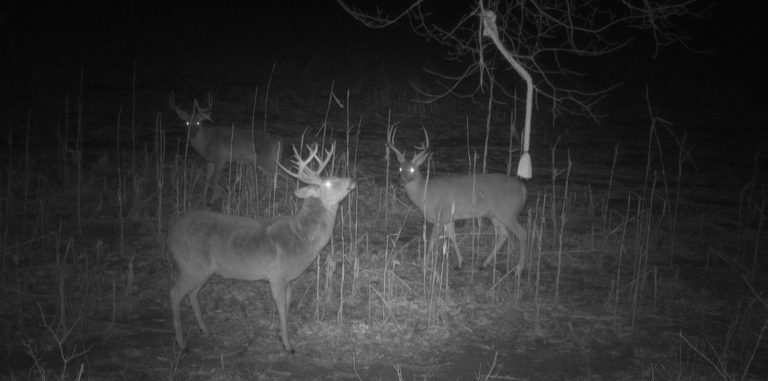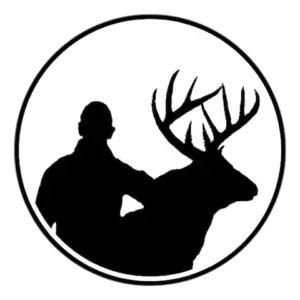If bucks were easy to see, then the majority of deer hunters would have a wall full of giant bucks. However, that’s not the case for most hunters. If you can understand why you don’t see bucks very often, then you can figure out what to do to give yourself better odds at seeing bucks, especially mature bucks.
The most likely cause for why you never see bucks is because of human intrusion from hunting pressure or from some other human activity. Other reasons why you might not see bucks is because there is a lack of quality food, bedding, water, and breeding opportunities close by. Lastly, deer will not tolerate dogs and will avoid areas where they are likely to be.
If you want to start seeing bucks more often then you need to understand how they choose their daylight bedding locations. Once you understand what a buck wants for daytime bedding, you will be able to use that knowledge to get close to him and increase your odds of encounters with him. If you have the ability to manipulate the habitat where you hunt then you can encourage bucks to bed at a specific location by creating your own preferred daytime bedding areas.
Where do big bucks hide during the day
Mature bucks value their own safety and security above everything else, including food and breeding opportunities. When bucks are pressured by human intrusion, they will move to areas that are perceived to be safer places to bed. Bucks usually find places to hide where the habitat provides enough cover to keep them out of plain sight.
One way to try and find where a big buck is hiding is through process of elimination. Try using an aerial map and mark off all the areas that are likely to have human intrusion. After you go through this process of elimination, hopefully there are some areas that are left unmarked. Start by looking for bucks in those unmarked area’s that still provide bedding cover. Also, try to focus in on the areas that would be difficult for human to access. I would place a higher priority on those areas.
Deer will find secure bedding areas in just about any kind of habitat you can think of. They will bed in swaps, marshes, standing corn fields, bottomlands, cedar thickets, grassy fields, etc. Some forms of cover are better than others which might provide you with another clue to help narrow in on preferred daytime bedding locations.
Deer all have different personalities. Some bucks will prefer bedding in tall grasses as their preferred habitat while others might like swampy areas. Bucks will still prioritize safety over the type of bedding habitat they choose to hide in. In other words, if a buck likes to bed in a swampy area but he keeps getting pressured out of the swamp, he will gladly move to a grassy area or some other safe bedding area instead.
If you were being hunted by a human, where would you go to survive? If you ask yourself that question while searching for bucks then you are on the right track to finding preferred buck bedding areas. Don’t overlook small pockets of cover that many hunters would never even consider hunting. These overlooked spots are the types of places where giants stay hidden year-after-year.
Why am I not seeing bucks during the rut
Are you having a difficult time seeing bucks during the rut? Have you asked yourself if there are even bucks in your area to begin with? If the answer is yes and you still aren’t seeing bucks then you need to ask yourself a few questions. Do bucks have a safe place to hide with food nearby (1-3 miles away)? And does the quality of those food sources and security cover outcompete the surrounding area? If the lands you hunt on have deer, cover, and food then you have the components needed to have a great rut hunt.
Let’s assume you have deer, cover, and food but you still aren’t seeing bucks. Why is that? Some hunters think that bucks will throw caution to the wind when the rut is on. But when it comes to mature bucks that couldn’t be further from the truth. Sure, bucks are definitely moving a lot more during daylight hours when the rut is in full swing and will even follow a doe in heat just about anywhere at any time during the day. However, deer are still very aware of human intrusion whether the rut is happening or not and they will avoid areas where they have encountered danger. You could be alerting bucks and does to danger without even knowing it which is why you might not be seeing bucks.
Are your hunting tactics well thought out so deer aren’t educated to your hunting pressure? If deer can hear, see, or smell you then you need to rethink your tactics, especially if you want to start seeing more bucks. You should even consider the scent you leave behind after a hunt is over. Everything that happens before, during, or after a hunt has potential to spoil a hunt or future hunts. It doesn’t take long for deer to respond to your hunting pressure. One negative encounter with a deer can ruin that hunting location for the next several days or weeks. By that time the peak rut might be over.
Lastly, are you putting in enough time in the tree stand to see bucks? Not all properties are going to have a buck walk through them every day. Some areas are better than others, offering higher odds of a buck walking by. If you are hunting an area with low buck numbers, or an area with low quality habitat and food, then you will most likely have to put in a lot of time to see a buck.

How to see more bucks
If you want to see more bucks then start by hunting areas where there is a good population of bucks and does. If you are limited on where you can go to hunt then try to find neighborhoods close to where you can hunt that have the best deer numbers. If you want to kill big bucks then you need to hunt them where they exist and where they spend their daytime hours. You can’t kill a big buck if he isn’t there. Some guys need to consider hunting a different county or a different state to meet their expectations of how many bucks they will see.
Once you find a good neighborhood to hunt, locate security cover where bucks can get away from human intrusion. Also, figure out where the main food sources are located. Once you understand where the preferred bedding areas and food sources are, that should give you a good idea how deer move back and forth between them. Use this knowledge when developing your hunting strategy. Regardless of what you might see on hunting shows, the majority of bucks are shot in security cover and not over a food plot. Spend most of your time hunting bucks within security cover or on the edge of it. A great place to see a buck is close to his bedding area or in transition zones between food and cover. Spend the majority of your hunting time in those locations.
You will see more bucks if you map out your hunting strategy and then stick to your plan. The quality of your hunting strategy should be based on how well you can hunt bucks without any deer being alerted that you are in the area. If you can’t enter and exit a tree stand location without educating deer then that’s not a good place for a tree stand if you plan on hunting at that location more than once.
Give yourself plenty of tree stand options. The more locations you have to hunt the better your odds are at seeing bucks. The first hunt in a tree stand is typically the best. If you hunt the same stand for every hunt then odds would say that your deer sighting will become fewer and fewer unless you have a bulletproof entry and exit to that hunting location. Try to have several tree stand options so you can hunt the same bedding areas with different wind directions. Also, have several different bedding areas set up to hunt in advance of hunting season. All of this will help you increase the likelihood of seeing bucks.
Once you know where to hunt you still need to put in your time in the tree stand. Don’t expect a buck to walk by on your first hunt. That’s why it’s important to have several tree stand locations to hunt from. In a perfect world you will have enough tree stand locations to where you never have to hunt out of the same stand twice. Many guys hunt the same tree stand or blind year-after-year and wonder why they never kill a good buck. If you are one of those guys then consider changing things up and do something different. You can’t keep doing the same thing every year and expect a different result.
Lastly, one of the best ways to see more bucks is by manipulating the habitat on a hunting property. Usually, you have to be a landowner to make habitat improvements, but not always. Sometimes you can find properties to hunt on permission that will also allow you to plant food plots or make other improvements for hunting. When your hunting strategy and habitat improvements on a specific property are working together, you can kill mature bucks year-after-year. Learn how to set up a property for deer hunting.
Conclusion
Seeing bucks can be difficult if you don’t know where to look. If you are having a hard time seeing bucks then the first thing you should ask is if human pressure is the reason why bucks aren’t showing themselves. Bucks want a secure place to bed and hide during the day and they have no problem waiting until darkness before getting up out of their bed to eat.
Bucks won’t throw caution to the wind even during the rut. Your hunting tactics need to be well thought out to ensure that bucks cannot hear, see, or smell you. Once you know where a buck likes to bed and feed then you need to hunt him smart and stick to your hunting strategy. Make sure you put a lot of time in the tree stand and bounce around different locations so that your hunting pressure is unpredictable. If you aren’t getting the results you are looking for, don’t forget to change things up.


